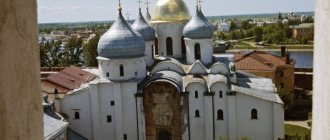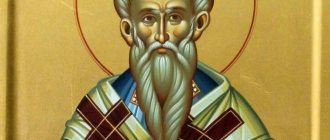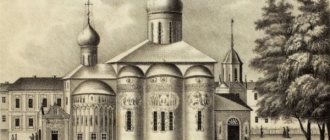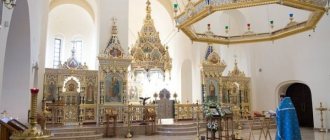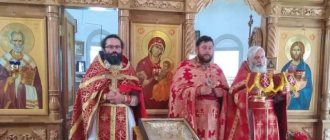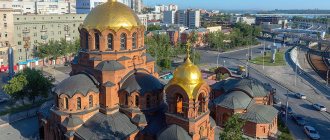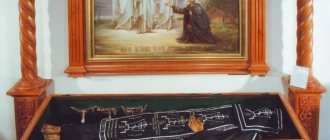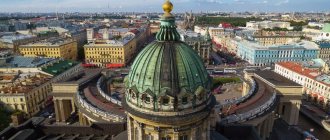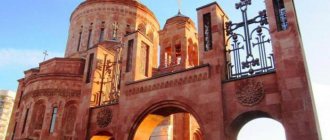Since ancient times, the Holy Trinity Cathedral has been the center of the most important events in the life of Pskov. Princes were baptized and received the title there, church services and solemn ceremonies were held. Many important chronicles and documents were kept in the temple archives. Trinity Cathedral in Pskov is one of the main attractions of the city.
History of the cathedral
The Trinity Cathedral of Pskov is one of the oldest churches in Russia; it was founded in the 10th century even before the construction of the St. Sophia Cathedral in Veliky Novgorod. But the building we see today is the fourth in a row.
All previous buildings were destroyed for various reasons, but each time the temple was restored:
- first building: 10th century - first half of the 12th century;
- second construction: 1138 - 1363;
- third building: 1365 - 1609;
- fourth building: 1699 - present.
First construction
The temple was built in the 10th century at the behest of Princess Olga. For construction, she chose a place on a hill fortified with palisades and earthen ramparts between the Velikaya and Pskova rivers. In the first half of the 12th century, the wooden building was completely destroyed by fire; neither its descriptions nor images were preserved.
Second building
The second cathedral was built of stone, and, according to legend, in 1138 it was founded by Prince Vsevolod Mstislavich, the grandson of Vladimir Monomakh.
On the eve of the famous Battle of the Ice in 1242, Alexander Nevsky prayed here, starting the tradition of holding prayer services in the Pskov church for the granting of victory to the Russian army.
Here the Lithuanian prince Dovmont received Orthodox baptism, whose sword for many years was presented to everyone who ascended the Pskov throne as a symbol of power. Then the princely sword was kept in the cathedral altar, and today it can be seen in the city museum.
In the Middle Ages, the cathedral had a two-story porch, facing the Vechevaya Square, where the veche gathered to decide the most important issues in the life of the city. In the vestibule itself, meetings of the State Council were held and cases of the secular court were heard. The cathedral housed the treasury, the state seal, archival documents and contracts. Also within these walls the monks kept a chronicle. High priests, princes and members of the princely family were buried in the basement.
The temple stood until 1363, when its vault collapsed. Just 2 years later, in 1365, a new cathedral, the third, was founded on its previous foundation.
Third building
The third building managed to stand for almost 250 years. Its architecture was significantly different from the previous ones: images of temples were preserved on ancient icons - they show that the third temple was three-domed, while the second had only one dome.
During the great fire of 1609, the building burned out almost completely; only the relics of Prince Vsevolod Mstislavich and the tomb of Prince Dovmont were preserved. The beginning of the 17th century was a difficult time for Russia, the Time of Troubles, when the country was tormented by Polish-Lithuanian intervention and internal strife. The Russian land was devastated, there were no funds for the restoration of the temple, so it was only renovated, and in 1682, construction of a new building began on the site of the shrine.
Fourth building
The construction of the fourth cathedral, which has survived to this day, took about 17 years and was completed in 1699. The new building was an order of magnitude superior to its predecessors, reaching 78 meters in height. It was a very large-scale structure; it could be seen from any corner of the city.
Several decades after construction, the building began to shrink unevenly; in order to save it, the open galleries had to be covered with bricks.
In 1770, to strengthen the structure, buttresses were erected around the quadrangle. The outer walls of the building were plastered, and the shrine took on the appearance familiar to us today.
With the advent of Soviet power, the temple was given to the schismatic “Living Church”. At the height of the anti-church campaign in 1935, the main cathedral of Pskov was closed, and an anti-religious museum was created inside. Many ancient shrines were transferred to the city museum-reserve, where they can be seen in our time.
A few final words
Any fortress is, first of all, a monument of defensive architecture. However, it must be remembered that in the Middle Ages people sincerely believed that the intercession of higher powers could provide no less help in battle than walls and towers. That is why in every fortress, be it the ancient Russian Kremlin or a Western European citadel, there was invariably at least one cathedral or just a church.
When it comes to Pskov, the Kremlin, the Trinity Cathedral and the walls of the Okolny town, I equally perceive them as part of a single fortification system that provided the Pskov residents with both physical and spiritual protection. The Church of the Holy Trinity is a full-fledged calling card of the city and not a single album dedicated to the beauties of the Pskov land is complete without a photo of the Trinity Cathedral. Pskov is a place where religion from time immemorial was perceived not as a system of prohibitions, but as the basis of the free spirit of the Pskov people.
Architecture and decoration
The Holy Trinity Cathedral was built in a mixed Russian-Byzantine style. Located on a natural elevation at the confluence of two rivers, the temple rises above the city to a height of 78 meters, being the architectural dominant of the historical part of Pskov.
Appearance
At its base lies a quadrangle on six pillars, which has the shape of a vertically elongated cube. The temple is crowned with five domes. Interestingly, the pillars are offset from the center closer to the eastern side of the building. In the Christian tradition, four small chapters are dedicated to the four Apostles-Evangelists, and the central one, sparkling with gold, is dedicated to Jesus Christ.
The building is adjacent to a closed gallery, which is connected to the vestibule, and two chapels. The basement of the old temple most likely served as the lower tier. Since 1903, there was a church dedicated to the memory of Seraphim of Sarov; behind its altar there was an ancient tomb.
Next to the cathedral is an 18th-century bell tower, decorated with a clock and a pointed spire. Despite the fact that the bell tower is designed in the style of classicism, it forms a single architectural ensemble with the temple.
Interior decoration
The main element of the temple interior is the iconostasis, located in the Seraphim chapel.
The iconostasis has been preserved since the 17th century; it rises 42 meters in height and contains seven rows of icons:
- Deesis series;
- forefather row;
- festive row;
- prophetic series;
- local row;
- icons depicting the Passion of the Lord (two upper tiers).
The iconostasis, decorated with gilded carvings, is crowned with a crucifix. In 1988, it was painted by the famous modern icon painter Archimandrite Zinon.
Trinity Cathedral is included in the category of monuments of republican significance, protected by the state.
Religion of medieval Pskov
Despite the fact that in the Middle Ages religious and cultural differences were much more acute than in our time, when it came to trade, they often faded into the background. That is why medieval ports and simple trading cities have always been centers of religious tolerance and cultural exchange between peoples.
In this sense, Pskov surprised me a lot: being for the rest of Rus', in fact, a window to Europe, this city until the beginning of the 16th century remained independent, isolated, and the Pskovites did not really favor strangers. Suffice it to say that all transactions with foreign merchants were carried out outside the Pskov fortress, the walls of which were prohibited for overseas guests to penetrate under pain of death. Of course, there was no talk of any Catholic or Lutheran churches on the territory of old Pskov. On the contrary, in terms of the concentration of Orthodox churches per square kilometer, the city is perhaps not inferior to Suzdal.
Externally, the main cathedral of Pskov seemed to me more elegant than other local churches, characterized by rough execution. The thing is that, in comparison with other churches in Pskov, this church in its current form was built only at the end of the 17th century.
Temple shrines
In addition to the unique iconostasis, in the temple you can see the relics of Pskov saints, ancient icons, some of which were painted in the 16th century.
Among the shrines especially revered by believers are the following:
- shrine with the relics of saints: princes Dovmont and Vsevolod of Pskov, martyr Joasaph of Snyatogorsk, blessed Nicholas of Pskov;
- ark with part of the Robe of the Blessed Virgin Mary;
- ark with the relics of St. Nicholas;
- the reliquary with the relics of Grand Duchess Olga;
- an icon with the relics of St. Seraphim of Sarov;
- image of the Chir Mother of God;
- image of the Kazan Mother of God;
- image of the Great Martyr Panteleimon.
One of the most amazing shrines is a shrine with the relics of the Lithuanian prince Dovmont, who took the name Timofey in baptism. In 1299, Livonian knights invaded Russian lands, ravaged the Pskov settlement and besieged the fortress. Prince Dovmont led his troops beyond the fortress walls and defeated the enemy, after which the Church canonized him.
Also in the Trinity Cathedral lie the relics of Abbot Joasaph, who founded the Snetogorsky Monastery near Pskov in the 13th century. He died defending Pskov from the Livonian knights in 1299; today Joseph is revered as a martyr.
Another saint, the holy fool Nikola Salos, who lived in the 16th century, is famous for not being afraid of the wrath of Ivan the Terrible, accusing him of cruelty and massacres, thereby preventing many executions of the inhabitants of Pskov.
Icons
The temple is also famous for its icons, some of which are modern paintings.
The main icon is considered to be the “Holy Trinity with Acts,” which is a composition of Old Testament stories and is revered as miraculous. The image of the Holy Trinity is covered with a gilded silver chasuble, the faces are crowned with silver crowns decorated with pearls and gilded.
The Chir Icon of the Mother of God received its name from the name of the village in the Chir region from where it was brought in 1420, when tears suddenly began flowing from the eyes of the Most Holy Theotokos. Soon, a pestilence epidemic broke out in the Pskov lands, after which the Pskov residents realized that the tears of the Mother of God were a harbinger of great trouble. In addition to the fact that the icon is revered as miraculous, it is two-faced, that is, painted on both sides - on the reverse side are depicted: the holy evangelist Luke and the Monk Theodosius of Pechersk.
Also in the temple there is an image of Saint Princess Olga, who laid the foundation for the Orthodox faith in Rus'. Among others, one should highlight the icons of the Pskov princes Dovmont, Vsevolod-Gabriel, the Great Martyr Panteleimon and two icons of the Mother of God.
Used materials
[1] “Priests of the PSKOV DIOCESE until 1917” Part 9. PSKOV”, official website of the Pskov diocese, September 12, 2013, -
[2] Archpriest John Georgievich Preobrazhensky (1915-1991), official website of the Gatchina city deanery,
[3] “Archpriest John Mukhanov: “A leader is a servant to all those whom he leads,” official website of the Pskov diocese, February 21, 2006,
[4] “Chronicle of the first ministries of Metropolitan Tikhon (Shevkunov) of Pskov and Porkhov, on the Pskov land”, official website of the Pskov Metropolis,
How are the services held?
Divine services in the Cathedral are held daily in Church Slavonic.
Schedule of services:
- Liturgy: 9.00;
- Evening Worship: 17.00;
- on Sundays: early Liturgy at 7.30, late Liturgy at 9.30.
The temple is open every day from 8.00 to 20.00. Entrance to the Kremlin territory and the cathedral itself is free. Church services are held in all four chapels: Kazansky, Trinity, Serafimovsky and Alexandrovo-Nevsky. The evening services at 5 p.m. are especially beautiful, during which the bishop's choir sings.
It should be remembered that the temple is active; the appropriate dress code must be observed. Photography indoors is only permitted without flash.
The Pskov Trinity Cathedral is the main symbol of the city, personifying its soul; residents still call it "House of the Holy Trinity". The temple in the Pskov Kremlin has long been the center of social and religious life.
Today it is not just a functioning temple, but also a cultural monument protected by the state.
Abbots
- Mikhail Kuninsky (XIX century)
- Mikhail Lavrovsky (October 1, 1895 - no earlier than June 29, 1917) [1]
- Sergiy Efimov (November 1941 - April 1942)
- Nikolai Zhunda (December 1943 - February 1944)
- John of the Preobrazhensky (1946 - July 1948), acting rector of the Pskov Kazan Church [2]
How to get there
The cathedral is located in the historical center of Pskov, on the territory of the Pskov Kremlin, north of the Olginsky Bridge over the Velikaya River. The Kremlin territory is a pedestrian zone where entry of any vehicles is prohibited.
You can get to the Kremlin by public transport (stop “Lenin Square”):
- Buses: 1, 7, 7A, 11, 15, 18, 19, 25, 30;
- Minibuses: 4A, 51, 51A.
Address: Pskov, Pskov Kremlin, 1.
Harmandir Sahib in India: The Golden Temple where people from all over the world come to learn goodness
Receive one of the most read articles by email once a day. Join us on Facebook and VKontakte.
The Sikh city of Amritsar was built back in the 16th century, and was named after the local lake, which has always been considered sacred. Sikhs believe that Buddha himself meditated on its banks. Now there is a luxurious pond, in the center of which a white and gold temple rises, reflecting its magical light in the clear water.
Walls of the Pskov Kremlin.
The walls of the Pskov Kremlin are about 9 kilometers long. They fence historical buildings on all sides and make the fortress impregnable. The height of the walls is about 6-8 meters, and the thickness ranges from 2.5 to 6 meters. There are walking platforms on top of the Kremlin walls. The longest is the eastern wall, its length is 435 meters. The shortest is the southern wall of the Pskov Kremlin, which is called “Persi”. Its length is 88 meters.
The Pskov Kremlin (Pskov Krom) is the greatest asset of Russia. This is a unique ancient structure with extraordinary architecture and excellent defensive capabilities. In 2013, the Pskov Kremlin was deservedly included in the list of 10 symbols of Russia.
Did you like the article? Share with your friends:
